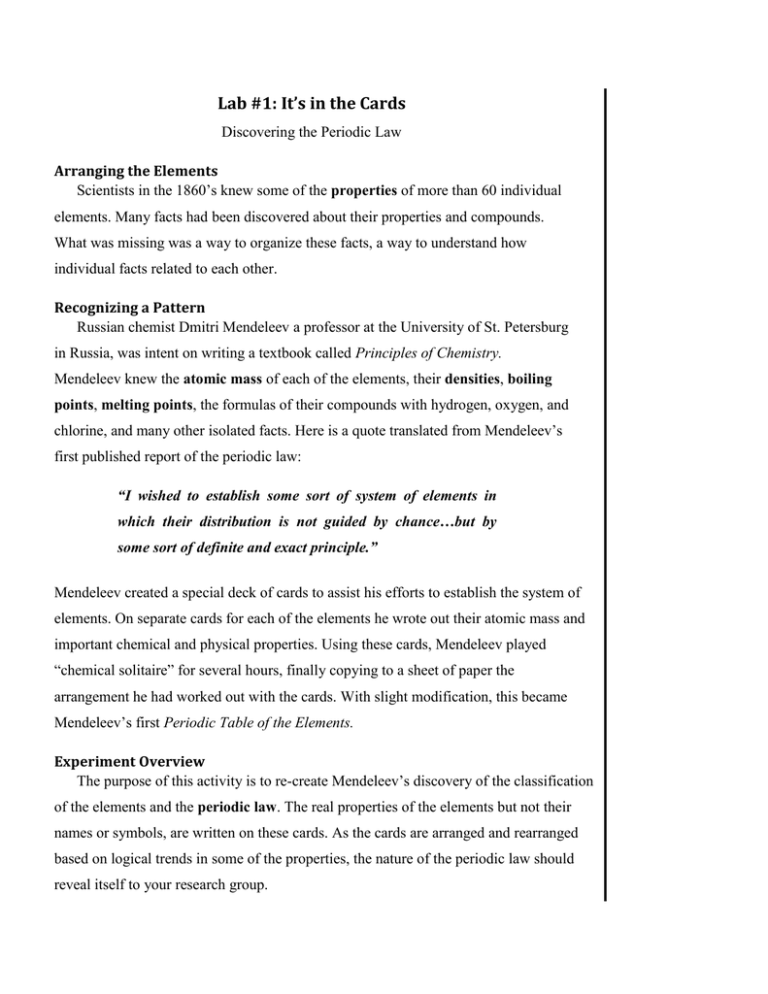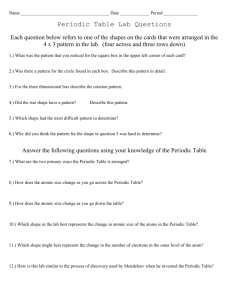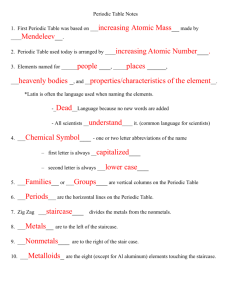It's in the Cards Lab Background and Procedure
advertisement

Lab #1: It’s in the Cards Discovering the Periodic Law Arranging the Elements Scientists in the 1860’s knew some of the properties of more than 60 individual elements. Many facts had been discovered about their properties and compounds. What was missing was a way to organize these facts, a way to understand how individual facts related to each other. Recognizing a Pattern Russian chemist Dmitri Mendeleev a professor at the University of St. Petersburg in Russia, was intent on writing a textbook called Principles of Chemistry. Mendeleev knew the atomic mass of each of the elements, their densities, boiling points, melting points, the formulas of their compounds with hydrogen, oxygen, and chlorine, and many other isolated facts. Here is a quote translated from Mendeleev’s first published report of the periodic law: “I wished to establish some sort of system of elements in which their distribution is not guided by chance…but by some sort of definite and exact principle.” Mendeleev created a special deck of cards to assist his efforts to establish the system of elements. On separate cards for each of the elements he wrote out their atomic mass and important chemical and physical properties. Using these cards, Mendeleev played “chemical solitaire” for several hours, finally copying to a sheet of paper the arrangement he had worked out with the cards. With slight modification, this became Mendeleev’s first Periodic Table of the Elements. Experiment Overview The purpose of this activity is to re-create Mendeleev’s discovery of the classification of the elements and the periodic law. The real properties of the elements but not their names or symbols, are written on these cards. As the cards are arranged and rearranged based on logical trends in some of the properties, the nature of the periodic law should reveal itself to your research group. It’s in the Cards Procedure Materials Special deck of 31 element cards Procedure 1. Each card lists the properties of a single element as shown below: * Units for density of solids and liquids are g/cm3 and g/L for gases. 2. Working as a collaborative group, discuss the possibilities for arrangement of the element cards, and look for a logical arrangement of the cards. Consider the following questions: a. What are the similarities and differences among the elements? b. Are there any numerical or logical trends in their properties? Mendeleev’s greatest insight in creating the periodic table was in recognizing that there were some gaps when the elements were arranged in logical order. He had the courage not only to leave blanks in his table for the missing elements, but also to predict their properties. 3. One of the element cards is also missing in your deck. Decide where the missing element belongs in the arrangement and rearrange the cards if necessary to make room for it. 4. After your team has decided upon an arrangement for the element cards, you will fill out the Data Sheet on the next page to diagram it. Do this by writing only the atomic mass of each element and leaving a blank space for the missing element. The table is 8 x 8 and contains 32 squares, which is many more than needed—leaving room for arranging the elements many ways. 5. Predict the properties of the missing element by averaging the properties of its nearest neighbors (in any direction). On the Data Sheet, complete the card for the missing element by entering its predicted properties alongside the name of each property. Name: ____________________ Date: _________ Period (Circle): 2 3 4 5 Data Sheet Table of the Elements When you have settled on an arrangement, write the atomic mass of each element in its final location. Properties of the Missing Element Ionization energy Atomic Radius Atomic mass Formula of its oxide Formula of its chloride Melting point Density Formula of its hydride Electronegativity Post-Lab Questions (Answer in your lab journal.) 1. Mendeleev’s Periodic Law can be stated: “The physical and chemical properties of elements are periodic functions of their atomic masses.” Looking at your arrangement of the element cards, describe in your own words what the term “periodic function” means. 2. Some of the properties listed on each card are periodic properties, others are not. Based upon your work rearranging the cards to make your version of the Periodic Table, name one property that is periodic and one that is not periodic. 3. Obtain a handout from your teacher that shows one possible arrangement of the element cards. This set identifies the atomic number and chemical symbol along with the element properties. Using this possible arrangement of the element cards, pick two of the numerical properties of the elements that are periodic and plot their values on the graphs below. Give a descriptive title to your graphs.





